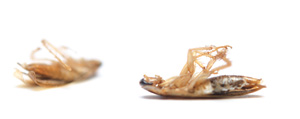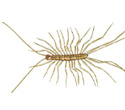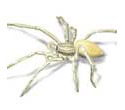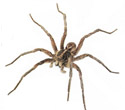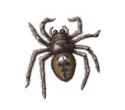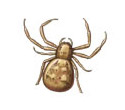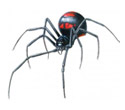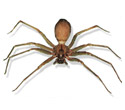| |
Ants
|
Argentine Ants - click for description
Size:
Workers of this species are about 1/8-inch in length.
Color:
Varies from dark brown to black, and the body is often shiny in appearance.
Argentine ants live in wet environments and position themselves near a source of food. They build enormous colonies, and emit a continuous trail, which allows them to retrace their steps as well as avoid visiting the same area twice. They give off a musty odor when crushed. Argentine ants prefer sweet, sugary foods but will eat almost anything. They do not pose any health threat but may contaminate food.
|
|
|
Carpenter Ants - click for description
Size:
Up to 5/8-inch long.
Color:
Varies from black, brown and black, red and black, to light brown depending on the species.The two most common pest species are black in color.
Carpenter ants feed on a wide variety of foods, especially other insects. The favored food of adults is the sweet honeydew produced by plant-feeding insects, such as aphids, scales, and mealybugs. In the spring, mature colonies produce winged reproductive ants, called swarmers, that fly out to start new colonies. These swarms often occur from satellite colonies within homes, so homeowners may see large flying ants in their homes at night. Carpenter ants can be very difficult to control, so most homeowners employ the services of a professional.
|
|
|
Crazy Ants - click for description
Size:
1/8-inch long, with extremely long legs and antennae.
Color:
Black
Crazy ants can adapt to different climates and conditions and are comfortable in both wet and dry areas. They will sometimes abandon one nest to create another. They often live in rotted window and door frames, bathroom walls and other decayed structures. They eat both live and dead insects, seeds and sweet foods such as Aphid dew.
Crazy ants get their name from the erratic, slightly jerky and unpredictable way they move about when searching for food. They will often enter homes in autumn or after rainfall and build nests under carpeting or floors. Outdoors their nests tend to be shallow and can be found in soil or near foundation structures. Crazy ants do not pose a health risk but can contaminate food and become a nuisance.
|
|
|
Odorous House Ants - click for description
Size:
About 1/8-inch long.
Color:
Brown
Odorous house ants may develop huge colonies containing thousands of workers and numerous queens. This species may be difficult to control and does not feed much on ant baits. The keys to control are to find the colonies and subcolonies and treat them directly. Regular inspections and service are necessary to find and treat new colonies as they move in from neighboring properties.
|
|
| |
|
Pavement Ants - click for description
Size:
About 1/8-inch long.
Color:
Brown.
Individual pavement colonies can often be controlled using ant baits, but perimeter inspection and treatment are commonly necessary for long-term relief.
|
|
|
Red Imported Fire Ants - click for description
Size:
About 1/8-inch long.
Color:
Dark Reddish Brown
Red imported fire ants dont usually infest structures, but instead in sunny open areas outdoors. They are extremely aggressive and will sting many times when there colony is disturbed. If left untreated they can build as many as 30-100 mound colonies that number around 80,000 each. They are attracted to electrical boxes and air conditioner units. They will feed on about any plant or animal matter.
|
| |
Biting Insects
|
Bedbugs - click for description
Size:
Up to 1/4-inch in length
Color:
Reddish-brown
Bedbug bites are painless and skin reactions may not show for 1-2 weeks afterward; many people are unaware when bed bugs have been feeding on their blood. Bed bug bite wounds may show as generalized minor swelling or raised bumps that itch. Fortunately, bed bugs are not known to carry or transmit any human disease, but the mere presence of any blood-feeding insect is disconcerting, at best. Getting rid of bed bugs can be extremely difficult. They may hide many feet from the bed in furniture, baseboards, doorframes, or even within voids in the wall until nightfall when they venture out to feed. When bed bug populations become large, or when a host becomes scarce because no one sleeps in the bed for a period of time, bed bugs may crawl into other rooms or squeeze through walls to enter neighboring locations. They may also be transported from place to place hiding in furniture, clothing, blankets, and other belongings.
|
|
Fleas - click for description
Size:
1/12- to 1/6-inch long
Color:
Reddish-brown
After each blood meal a female cat flea lays 4-8 eggs among a host animal’s hairs or in its bedding area, amounting to 400-500 during her life. Eggs are tiny white ovals, about 1/64 in (.5 mm) long, which take 1-12 days to hatch. They may fall or be shaken off into crevices where the animal sleeps or spends time. Larvae need high relative humidity (45-95%), going through 3 instar stages in 1-2 weeks to several months. Cocoons (pupae) with camouflaging debris on the surface last 4-14 days, up to a year. The pre-emerged adult stays in the cocoon for up to 20 weeks, protected from dangers such as pesticides. Adult fleas look for a blood meal soon after emerging, but can survive for several months on stored fat. Once on a host, they feed, mate, and lay eggs. Many adults live only a few days, as cat grooming removes up to half of them, but survivors can live about one year.
|
| |
|
|
|
Asian Tiger Mosquito - click for description
Size:
About ½ inch in length
Color:
Dark brown or black with numerous white bands on the body and legs
The mosquito not only takes our blood in order to provide nutrients to make eggs, which is an annoyance resulting in minor pain and itching, but it can leave behind serious health threats such as viruses, protozoans, and other disease-causing pathogens. The mosquito is actually a type of fly with a thin body, thin wings and long legs. The females are easily recognized by the long thin proboscis, or mouthparts, extending from the bottom front of the head. Only the female mosquito bites; male mosquitoes feed on the nectar in flowers. When a mosquito bites, she injects an anticoagulating agent into the skin to prevent the blood from clotting and allowing her to feed. It is the body’s immune response to the anticoagulant that causes the reddened welts and itching. People have varying reactions to mosquito bites, with some individuals experiencing rather large welts and severe itching. Mosquito-borne disease is likely the number one cause of death in developing countries, and it has many times been instrumental in changing the course of history. Fortunately, the United States is fairly free of mosquito-borne diseases except for various types of encephalitis, most notably West Nile Virus (WNV) in recent years.
|
|
|
Ticks - click for description
Size:
1/16- to 5/8 inch long
Color:
Varies
Ticks vary in color by species. Adult ticks are smaller than a sunflower seed (1/8- to 5/8-inch long if engorged with blood), while nymphal (or immature) ticks are less than 1/16-inch. Common problem ticks include the American dog tick, deer or black legged tick and lone star tick. Often found near wooded and highly vegetated areas. Some species require moisture to survive. here are four stages in a tick’s lifecycle – egg, larvae, nymph and adult. Ticks have only six legs during their larval stage and eight legs during their nymphal and adult stages. They consume blood meals during all stages. Pathogens, or organisms that cause diseases in the animals they infect, can be passed through the stages of a tick’s life cycle.
|
| |
|
|
|
|
Cockroaches
|
American Cockroaches - click for description
Size:
Up to 2 inches long.
Color:
Reddish brown.
Like all cockroaches, it is omnivorous and will eat virtually anything people will and many things we won't. They prefer warm, moist areas. When located inside homes they are often found in basements, around sewers, and around other areas of moisture.
|
|
German Cockroaches - click for description
Size:
About 1/2-inch in length.
Color:
Brown.
The German cockroach is the most prolific breeder among all cockroaches. Each egg capsule can contain up to 40 eggs and development from egg to adult can occur in as little as 45 days. Like all cockroaches, it is omnivorous and will eat virtually anything people will and many things we won't. They prefer to live in small cracks and crevices inside kitchens, bathrooms, and other areas where moisture is present. When infestations are very bad, they can be found throughout an entire home.
|
|
| |
|
|
|
Oriental Cockroaches - click for description
Size:
Both male and female are about one inch in length.
Color:
The female is all black, while the male has two brown wings.
The oriental cockroach is a pest in homes throughout much of the United States. It is rarely seen in southeastern states, however. During the summer, oriental cockroaches move outdoors where they may venture into neighboring buildings. During the colder months, they reinvade homes, establishing themselves in basements and crawl spaces.
|
|
Asian Cockroaches - click for description
Size:
Adults measure about 1/2-inch in length.
Color:
Tan brown -- looks identical to the German cockroach.
This species lives primarily outdoors and is considered a nuisance pest as it seldom breeds inside homes. It is active at night and readily flies to lights on buildings where it crawls inside. It may be seen indoors during the evening, flying toward a television or other light source. Large populations can develop near buildings, so regular invasions are common where this cockroach occurs. The Asian cockroach looks identical to the German cockroach, and it can only be distinguished if seen in flight because the German cockroach cannot fly.
|
| |
|
|
Fabric Pests
|
Carpet Beetles - click for description
Size:
Tiny, round beetles with larvae that grow up to 1/4-inch in length; the adults grow to 1/16-inch.
Color:
While generally tan in color, they are covered by tiny black, brown, and white scales, and have numerous tufts of stiff hairs on the body.
Fabric pests such as carpet beetles, although not particularly dangerous, can sometimes cause irreparable damage to personal belongings. These beetles are able to digest animal hairs and, therefore, feed on almost any item made of natural fibers, particularly wool and cashmere.
|
|
|
Indian Meal Moths - click for description
Size:
1/2 to 5/8th of an inch in length.
Color:
Rear half of the wings is distinctly reddish brown or bronze colored.
Indian meal moths begin their life cycle as eggs laid by females directly on or inside packaging of food products. The eggs hatch into larvae that resemble small, creamy-white caterpillars but that are more worm like with brown heads and bodies that can sometimes be tinged pink or green depending upon what they are feeding upon. Damage to stored food products is caused by the larvae spinning silken threads as they feed and crawl, thus webbing food particles together. The larvae feed on such food products such as dried fruits, powdered milk, cornmeal, flour, raisins, prunes, nuts, chocolate, bird seed, dry dog and cat food, fish food, graham crackers, pastas, etc.
|
|
|
| |
|
|
Occasional Pests
|
Centipedes - click for description
Size:
Most centipedes found around buildings rarely measure longer than 2 inches.
Color:
Varies depending on the species. Most are brownish or orange-brown.
Centipedes are predators that live in moist areas. These nocturnal creatures hunt down insects and spiders at night. Centipedes are distinguished from millipedes in that they have only one pair of legs per body segment, while millipedes have two pairs of legs per body segment. They are seldom seen inside homes, except for the house centipede which may breed in crawl spaces and basements. The house centipede is recognized by its extremely long legs.
|
|
|
House Centipedes - click for description
Size:
Up to 1½ inches long
Color:
Grayish yellow with dark bands on legs. Body has three dark, longitudinal stripes.
The house centipede may well be one of the scariest household pests by appearance alone. The slender body is adorned on either side by numerous, very long legs, and it moves very quickly which can be disconcerting to many homeowners. This centipede is harmless, however, and is actually a beneficial creature, feeding on spiders and insects found within the home.
|
|
|
| |
|
|
|
Crickets - click for description
Size:
Varies, though usually no larger than 1-1/2 inches in length.
Color:
Generally black or brown.
Crickets generally live and breed outdoors and invade buildings searching for food, moisture, or shelter. The adults are attracted to bright lights on buildings and may fly to homes and other buildings by the dozens or even hundreds (in mid- to late summer). Once near the building, crickets will crawl through any crack or hole that allows them access inside. These insects have been known to feed on and damage clothing, usually items that are soiled and awaiting laundering. Camel crickets do live and breed indoors, usually in a crawl space, cellar or basement. They occasionally wander up into the living areas of the home where their quick jumping ability can startle the unwary person. Camel crickets may also invade homes from wood piles and similar areas outside.
|
|
|
Millipedes - click for description
Size:
Generally small, about two inches or less in length. Some forest species in the southeastern United States may grow to four or more inches.
Color:
Brown or black.
Millipedes live in moist vegetation, leaf litter, and mulch. They feed upon decaying organic matter found in these areas. Millipedes are distinguished from centipedes in that they have two pairs of legs per body segment, while centipedes have only one pair of legs per body segment. Although dozens of millipedes may be found outside buildings, few may wander inside. If they do, millipedes usually die very quickly due to lack of moisture. They can, however, survive indoors in moist basements and crawl spaces. Under the right conditions, millipede "migrations" can occur. Where considerable amounts of decaying organic matter are found, such as thick leaf litter under trees or thick thatch layers in lawns, thousands of millipedes might be produced. If the area where they live dries out, becomes too wet, or the millipede population grows too large, a migration may occur. Thousands of millipedes begin crawling in search of better living conditions. In a few cases, hundreds of thousands of millipedes are present. In such cases, keeping all millipedes out of a building is likely impossible.
|
|
|
| |
|
|
|
Rodents
|
Deer Mice - click for description
Size:
Body is up to two inches in length.
Color:
All species are bicolored -- the top is light brown to red-brown and the feet and underbelly are pure white.
Unlike the house mouse, the deer mouse is not found in cities but is associated more with rural areas and buildings located in or near wooded areas. It does not commonly invade homes, but in rare instances one or more deer mice may invade a particular building. You should avoid any area where infected deer mice have frequented unless wearing proper protective gear.
|
|
House Mice - click for description
Size:
Small, its body rarely exceeding two inches long and one ounce in weight.
Color:
Usually gray in color, but some may appear darker.
House mice are the most common rodent pest in most parts of the world. They breed quickly and often and can rapidly adapt to changing conditions. Usually, most home invasions occur in the fall, not because of cooler weather, but because the seeds and plants on which rodents feed outside are gone. Mice are excellent climbers and are capable of gaining entry through holes around soffit vents and around cables entering the building, through holes in gable vent screens, and through turbine and box vents on roofs. Most garage doors on homes allow enough space for mice to fit underneath, as well.
|
|
| |
|
|
|
Norway Rat - click for description
Size:
Larger rodents that may grow to a body length of 10 to 12 inches. Seldom will a rat weigh more than one pound.
Color:
Can vary from gray to brown to black.
Norway rats have migrated to the US and often live in fields, wood piles and farmland but have adapted to urban life over time and will also reside in sewers and areas where garbage is strewn. They can squeeze through spaces smaller than a nickel. Norway rats will eat almost anything and feed on human trash, seeds, meat, dairy products, bird seed, dog feces and compost piles. Norway rats are extremely dangerous and can introduce fleas, lie, mites and ticks into your home. Their droppings can spread harmful germs and contaminate food. They can also chew through wirings, which may pose a fire hazard.
|
|
Roof Rat - click for description
Size:
Seven to 10 inches long, with a long tail, large ears and eyes, and a pointed nose. Body is smaller and sleeker than Norway rat. Fur is smooth.
Color:
Can vary from gray to brown to black.
Roof rats are typically found in the upper areas of buildings but will also make their homes in and under buildings. Roof rats will eat almost any food they find and will also chew through other materials.
|
| |
|
|
Spiders
|
Yellow Sac Spiders - click for description
Size:
Small, approximately ½ inch long
Color:
Pale yellowish color
Yellow sac spiders fast moving spiders that can be found in nearly any room throughout the home. In the fall, yellow sac spiders move indoors in large numbers and remain active for several months. They are known for resting in silken sacs during the day and actively hunting at night for other small insects, including other spiders. As they hunt, they often encounter humans (typically by accident) and may bite when brushed against or pinched. It is suspected that the yellow sac spider accounts for more bites on people than any other spider in the US, but thankfully their venom produces only minor, localized pain and swelling similar to a mosquito bite.
|
|
Wolf Spiders - click for description
Size:
Wolf spiders come in many sizes with most having a body size ranging from 1/4-inch to more than 1 1/2 inches in length. The largest species may have a leg measuring up to 3 inches or more leading many homeowners to mistake them for tarantulas.
Color:
Most wolf spiders are brown although some may appear black.
Wolf spiders are active hunters which search for prey during the day or night, depending on the species. These common spiders may live in significant numbers around homes and other buildings, especially those structures which have lush landscaping. Wolf spiders enter underneath doors or through cracks in the exterior walls. Wolf spiders are unique in that they carry their egg sacs from the tip of their abdomens attached to the spinnerets. The young spiderlings also ride on the mother’s back for a few days after hatching. Bites involving wolf spiders are rare and are not dangerous.
|
|
| |
|
|
|
Jumping Spider - click for description
Size:
The body is usually 1/2-inch or shorter in length.
Color:
Color varies, most being black or gray. Some are brightly colored or possess bright markings.
Jumping spiders are among the spiders more commonly seen around homes because they are active during the day. They are recognized by their stout, robust bodies, quick movements, and remarkable feats of jumping. They have two very large eyes in the bottom front row of eyes which they use to locate prey during their daytime hunting forays.
|
|
Crab Spiders - click for description
Size:
Body is usually less than 1/2-inch in length, but up to one inch in larger species.
Color:
The crab spider’s color varies, but most species are brown. Some are brightly colored in yellow, green or even pink, depending on the type of flower they frequent.
Crab spiders are passive hunters that ambush their prey. These spiders wait patiently on plants and flowers for flies, bees, butterflies and other insects to visit, and then they pounce upon the unsuspecting insect.
|
|
| |
|
|
|
Black Widow Spiders - click for description
Size:
Body may be up to 3/4-inch in length with the abdomen reaching 3/8-inch in diameter.
Color:
Typically glossy black but may also be dark brown to light brown. Related widow spiders may be brown.
The black widow spider is widely feared because its bite results in severe pain that may take several days to subside. Such bites are rarely fatal but small children and elderly persons are at risk. Black widow spiders construct irregular, scaffold-type webs usually near the ground level. These webs are almost always constructed in a protected site such as among items piled together, beneath boards, in firewood, and between boxes. Newly hatched spiderlings climb to high points, release a strand of webbing and are propelled by "ballooning" to new locations. For this reason, buildings may have new spiderlings float to it on a regular basis. Most of these do not survive. Black widows eat any insect they can capture. It is not true that the female always consumes her mate after mating, but it does frequently occur. Black widows are classified as dangerous spiders because their bite can cause severe cramping and pain throughout the body. Very young children, the elderly, and very ill persons are most at risk for severe reactions to the bite of this spider.
|
|
Brown Recluse Spiders - click for description
Size:
May grow to have a body about 5/8-inch in length and a leg span of about one and a half inches in diameter.
Color:
Usually light brown but may be darker in some specimens.
Like most spiders, the brown recluse spider does not seek to bite people. The bite is usually accidental. The spider crawls into a shoe, into clothing or into a bed and a person then puts on the clothing or lies on the spider in bed. The spider, being trapped, has only one defense - and that is to bite. Unfortunately, the bite of this spider produces a nasty result in people, such as open, ulcerating sores. Left untreated, such bites often become infected and significant tissue necrosis can occur. It is always best to seek medical attention, preferably from a dermatologist, if you think you may have a spider bite. This is especially true in areas where brown recluse spiders are common.
|
|
| |
|
|
Stinging Insects
|
Paper Wasps - click for description
Size:
Most species are about 1 inch in length, but a few may be as small as 1/2-inch or as large as 1-1/2 inches.
Color:
Many are reddish-brown or dark red. Some species are more orange, while others have varying bright stripes of red and yellow.
The key to identifying paper wasps is the shape of the nest -- a round, upside-down paper comb that is attached by a single stalk to a horizontal surface in a protected location. This paper nest resembles an umbrella, lending to these wasps nickname, "umbrella wasps." The colony starts out each spring as a single queen that has overwintered in a protected site, such as beneath bark, within leaf litter or inside the walls or attics of buildings. The queen finds a suitable nesting site and constructs a small comb nest in which she raises her first brood of larvae. These larvae mature into adult workers which then begin to forage for food, care for the new young, and enlarge the nest. Paper wasps are predators and feed on insects, spiders, and caterpillars. Most paper wasp colonies number only a few dozen workers, but under the right conditions, a colony might produce more than 100 workers. In early fall, the colony produces queens which fly out to find a site to overwinter.
|
|
|
Yellow Jackets - click for description
Size:
About 1/2 -to 1-inch in length.
Color:
Generally small wasps with black and yellow stripes.
Yellow jackets are social insects that live in colonies containing thousands of individuals. Colonies are usually started by a single queen in the early spring, and are very small for the first couple of months. By midsummer, a colony located on or near a house is usually large enough to become a nuisance. These wasps will aggressively attack when their nest is disturbed, and can inflict painful stings. Unlike the honeybee, which stings only one time and then dies, a single yellow jacket can sting many times. Yellow jackets are scavengers and can be beneficial when located in a wooded area or a field. Colonies located in or near a home, however, can pose a threat to the persons living in the house. When this situation is discovered, the colony or colonies should be eliminated by a professional.
|
| |
|
|
European Hornets - click for description
Size:
1 to 1-1/2 inches in length.
Color:
Golden brown with darker brown stripes and markings on its thorax and abdomen.
European hornets are social wasps which form colonies that live for one year. Each spring, an overwintering queen will find a suitable nesting site and construct a small paper nest. Inside the nest, she builds a small paper comb in which she raises her first brood of larvae. After these larvae mature into adults, these worker wasps begin nest enlargement and food foraging for the colony. The paper in the nest and the comb are made from bits of wood scraped from logs, bark, and even the wood on decks and houses. Like bald-faced hornets and yellow jackets, European hornets aggressively defend their colony if it is disturbed. Loud vibrating noises, such as those from lawnmowers and leaf blowers, can "set off" the hornet workers causing them to sting people and pets. The colonies of European hornets may contain several hundred workers by the end of the season.
|
|
Honeybees - click for description
Size:
1/2-inch in length.
Color:
Golden-yellow in color with darker bands of brown.
Honeybees are beneficial, social insects and the only type of social bees in the U.S. that establish perennial colonies which can survive for a decade or longer. These bees forage on pollen and nectar from flowering plants and use these materials to produce the honey that will feed the colony through the winter months. Waxy honeycombs will fill the nest cavity, a fact that makes removal of honeybees from buildings a messy chore. All honeybee colonies produce queens and drones in the spring. These reproductives mate, and the queens may "abscond" with a number of workers to start new colonies. These swarms may be seen clustered on a tree branch, a fence, or a building as the bees rest before flying off again to find a suitable nesting site. Because hundreds of bees are part of this swarm, people are often concerned about the possibility of the bees attacking. Usually, the bees in these swarms are docile and nonaggressive unless vigorously disturbed.
|
|
| |
|
|
Bumble Bees - click for description
Size:
Ranges up to 1 inch in length.
Color:
Usually black with yellow stripes on the thorax and abdomen.
As social insects, bumblebees live in colonies. Each spring a queen that has survived overwintering will find a suitable nesting site and establish her colony. Her first brood of eggs mature into workers that forage on pollen and nectar for food. The workers do produce honey, but it is not edible to humans. The bees will attack to defend their nest, so they are considered a health concern. During the fall, the colony produces a number of queens that fly out to find protected sites to spend the winter and thus repeat the cycle next year.
|
|
Carpenter Bees - click for description
Size:
The species of most importance are about 1-inch long and have a robust, bee-like shape.
Color:
Like bumblebees, carpenter bees are black with some yellow.
Behavior:
Carpenter bees chew out tunnels in wood in which to lay their eggs and provide a protected site for their larvae to develop. The female bee selects a suitable log or piece of wood and chews a round, 1/2-inch diameter tunnel into the wood. About one-inch deep, she turns at a right angle and chews a tunnel (nest gallery) about 12 inches in length. The bits of wood she chews off are deposited outside the nest and end up on the ground below. These bits of wood, called frass, often are streaked yellow from pollen on the female s legs. An egg will be deposited at the end of the nest gallery; the female will then pack the gallery about an inch deep with pollen. This process is repeated until the entire gallery has been filled. The male carpenter bee guards the outside of the nest and tries to chase away potential predators. He does not have a stinger, but still causes concern with his aggressive buzzing if people venture near the nest site.
|
|
| |
|
|
Termites
|
Dampwood Termite - click for description
Size:
King and queen bodies range from 1/2- to 5/8-inch. Nymphs range up to 5/8-inch. Soldiers range up to 3/4-inch in length.
Color:
Kings and queens are brownish in color.
Dampwood termites are social insects that live in colonies consisting of several specialized forms. A mature colony may release "swarmers" (winged males and females) in late spring through fall, depending on the species. The swarmers have well-developed eyes, are pigmented in various shades of brown, and often have wings that are "smoky" in appearance. After pairing, males and females will shed their wings and may infest stumps and fallen logs. They now become the king and queen of a new, developing colony. The majority of the dampwood colony consists of nymphs (immatures) that are pale and soft-bodied. Although they have no true worker caste, the nymphs perform the basic "house-keeping" duties similar to subterranean workers. This involves enlarging the gallery system, tending to the needs of the king and queen, care of the eggs and newly hatched young, and obtaining food for other colony members. As nymphs mature, they become reproductives (alates) or soldiers. The soldiers have pale, soft bodies, but large, dark, hard-shelled heads with powerful mandibles. The soldiers defend the colony against invasion by ants. Because their mandibles are so specialized, they are unable to feed themselves, and must rely on care from the nymphs. Physically, dampwood termites are larger than the subterranean and drywood termites, and the dampwood soldier can be quite formidable in appearance.
|
|
Drywood Termite - click for description
Size:
Soldiers measure 3/8-inch in length; male and female reproductives grow to 1/2-inch long. During the winged stage there are four equal size wings that extend longer than the body by 1/8- to 1/4-inch.
Color:
Usually pale brown.
Drywood termites are social insects that live in colonies. The colonies are composed of kings, queens and soldiers. There is no worker caste as in subterranean colonies. The work is performed by immature termites before they become adults. King and queen termites perform the reproductive functions of the colony. They are light to dark brown and 1/3- to 3/8-inch in length. Soldiers guard the colony against invaders such as ants. They are pale, cream colored and wingless with large brownish heads and jaws. The nymphs (immatures), which are the most numerous caste, are pale, cream colored and wingless. The soldiers and immatures remain inside the wood at all times.
|
|
| |
|
|
|
Formosan Subterranean Termite - click for description
Size:
About 1/2-inch overall length, including the wings.
Color:
Yellowish brown
Formosan termite colonies begin small, with a single pair of reproductives - a king and a queen - but may grow to contain several million individual termites. Initially, the king and queen establish the new colony by producing 15 to 30 eggs. Two to four weeks later, the nymphs hatch and are nursed by the reproductives. The queen deposits a second batch of eggs one to two months later. The first batch of nymphs takes over the nursing responsibilities. The first new termites produced are workers. As the colony grows, soldiers are produced and finally, three to five years after the colony is started, winged reproductives are produced. A mature queen can live more than 15 years and deposit as many as 1,000 eggs per day. A mature colony may produce more than 20,000 reproductive alates each year. Alates, or swarmers, do not reproduce in their original colonies. They swarm out of the colony by the thousands along with alates from nearby colonies. Each alate attempts to pair with an alate of the opposite sex from a different colony. Few survive this quest. Those that are successful become the kings and queens of the new colonies. Swarming usually follows a warm, rainy day in late spring or early summer, most often in May and June, and typically occurs in the evening between twilight and midnight.
|
|
Subterranean Termite - click for description
Size:
Worker: 1/8- to 3/8-inch in length. Soldier: Body is similar to that of the worker, but large, deck head with powerful mandibles. Supplementary Reproductive: About one inch in length. Primary Reproductive: About one inch in length.
Color:
Worker: Pale, cream colored. Soldier: Light colored with brown head. Supplementary Reproductive: Light colored. Primary Reproductive: Dark brown/black.
This termite is known to swarm in spring, but small flights can occur at any time of the year. Swarming is the visible means that termites use to establish new colonies. As the colony grows, specialized castes are produced for the different tasks required. One caste produced is the workers. Another caste is the soldiers. And a third caste is the reproductives. Primary reproductives swarm and start new colonies. They are called alates or swarmers. Although thousands of primary reproductives may be produced each year, they all leave the nest. Supplementary reproductives, on the other hand, can become reproductive only in the colonies in which they were born. They assist the primary king and queen in population growth of the colony.
|
|
| |
|
|
|
